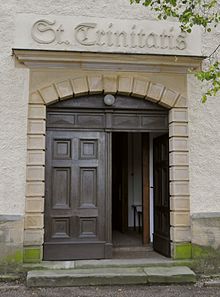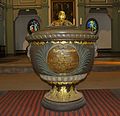Saint Trinity Church (Ohrdruf)
The St. Trinity Church has been the Protestant parish church of Ohrdruf in Thuringia since the destruction of the Michaeliskirche in the city center in February 1945 . Until then it was the only suburban and garrison church .
history
There was the beginning of the 16th century outside the southern city walls of Ohrdruf in the suburbs - the "Long corpse," the Street Leichhardt field near still remembers - the Lorenz Chapel or the Holy cottage. The first evangelical sermon was held there in 1525. In 1533 the chapel had to be demolished because it was dilapidated. Since then, the congregation of the suburb was without its own church and in the former parish church of St. Michael the parish .
At the beginning of the 18th century it was decided to build a new church “for the glory of God, for edification in the Christian class and for the prevention of all kinds of nuisance”. On April 17, 1709, in the presence of Duke Friedrich II of Saxe-Gotha-Altenburg, the foundation stone was laid for the building, the plans of which were drawn up by the Saxon-Gotha builder Johann Erhard Straßburger . On June 17, 1714, the church was consecrated to the Trinity of God (Trinity). The small organ, the former Rückpositiv of the St. Michaelis Church, was played by the Bach brother Johann Christoph Bach , who worked there as an organist and died in Ohrdruf seven years later.
The interior of the baroque church is equipped with a double gallery running on both sides, stately homes (niches for the authorities) on the side of the altar and a flat wooden ceiling. In 1746/47 the organ builder Johann Stephan Schmaltz from Wandersleben installed an organ, which was replaced in 1814 by a new organ from Georg Franz Ratzmann's workshop in Ohrdruf . The ceiling panels were painted in 1895 by the Ohrdruf painter and drawing teacher Bruno Kohlmann.
In 1927 the chancel was redesigned when the church was rebuilt, a winter church and community rooms were built on the first floor. The church also received warm air heating. Thanks to a foundation made by community members, the Weimar art glass maker Krause created eight lead glass windows with Bible motifs based on designs by Paul Birr , Berlin. The figure of Christ in the altar wall dates from 1935.
During the renovation of the interior of the church in 1980, the pulpit was moved from the rear altar wall to the left side of the nave near the stalls; their old location was adorned with a baroque crucifixion painting. On October 4th, 1992 the Ratzmann organ restored by Förster & Nicolaus from Lich was inaugurated again. The completion of the outer facade and the tower beam took place in 1997/98, in 2006/07 the organ was completely renovated again.
The font from around 1680 probably comes from the chapel of Ehrenstein Castle.
A bell of the church comes from the Gotha bell founder Paul Seeger (1648–1721).
The church is often used for concerts.
organ
The organ goes back to an instrument from 1814, the third organ of the Trinity Church, built by the organ builder Georg Franz Ratzmann . The instrument has 34 stops on two manuals and a pedal. The actions are mechanical. It was last restored in the years 1990-1992 by the organ builder Förster & Nicolaus (Lich).
|
|
|
||||||||||||||||||||||||||||||||||||||||||||||||||||||||||||||||||||||||||||||||||||||||||||||||||||||||||||||||||
- Coupling : II / I, I / P
The Church and the "Bachs"
The church had a close cooperation with members of the Ohrdrufer lineage of the Bach musician family:
- 1714 to 1721 Johann Christoph Bach , cantor and teacher, founder of the Ohrdrufer Bach line, organist
- 1714 to 1717 Tobias Friedrich Bach , 1st son of Johann Christoph, cantor and teacher, organist
- 1721 to 1743 Johann Bernhard Bach , 2nd son of Johann Christoph, organist
Since the church was a parish church from 1738, there were independent organists from 1742:
- 1742 to 1779 Johann Andreas Bach , 8th child of Johann Christoph, organist (from 1744 to 1753 organist at St. Michaelis)
- 1779 to 1814 Johann Christoph Georg Bach , son of Johann Andreas, with him the last organist of the Bach line dies in the third generation in Ohrdruf.
- Johann Christoph Bach , 3rd son of the aforementioned Johann Christoph, canton and teacher from 1728 to 1756 in Ohrdruf, composed a cantata for the festive service for the inauguration of the new second organ in St. Trinity on June 18, 1747.
- Philipp Christian Georg Bach (1734–1809) worked as a deacon in St. Trinitatis in 1772 and was cantor from 1757 to 1772 before he became pastor in Werningshausen .
- Friedrich Bernhard Christian Bach (1819–1862) had also been a deacon since 1860.
- Ernst Carl Gottfried Bach (1738–1801) was the last cantor of the Bach line from 1772 to 1801.
- Ernst Carl Christian Bach (1785–1859), son of the aforementioned, was pastor from 1817 to 1821 and from 189 to 1859 as Ohrdrufer superintendent. He was the last pastor of the Bach line in Ohrdruf.
The Leichviertel
The quarter in which the church was built offered several advantages compared to an inner-city location: generous freedom of movement for agricultural teams, better protection against fire disasters that often struck several houses (rows) in the inner-city area, a location rich in flowing water (Ohra and tributaries) for development several trades, the wide arterial and trade road leading to the Thuringian Forest (today the L 2148 - "Waldstraße"), on which the church is located, the many mills fed by the Ohra (Lappmühle, Königsmühle, Weisse Mühle, Walpertsmühle, Zwietrachtsmühle, Fiedlersmühle, Waldmühle and Tobiashammer ), Sahlender Mühle (1593).
The origin of the name Leichviertel can be found in ahd. Leih , as much as played manner , which points to an earlier playground or a festival area. The church was popularly known as the "Leichkirche".
literature
- Brochure from the Evangelical Lutheran Church Community of Ohrdruf
- Ellrich / Heinke / Hoerenz: Between Hörsel and Wilder Gera , Weimar 2005, ISBN 3-86160-167-2
Individual evidence
Web links
Coordinates: 50 ° 49 ′ 23 ″ N , 10 ° 44 ′ 5 ″ E









